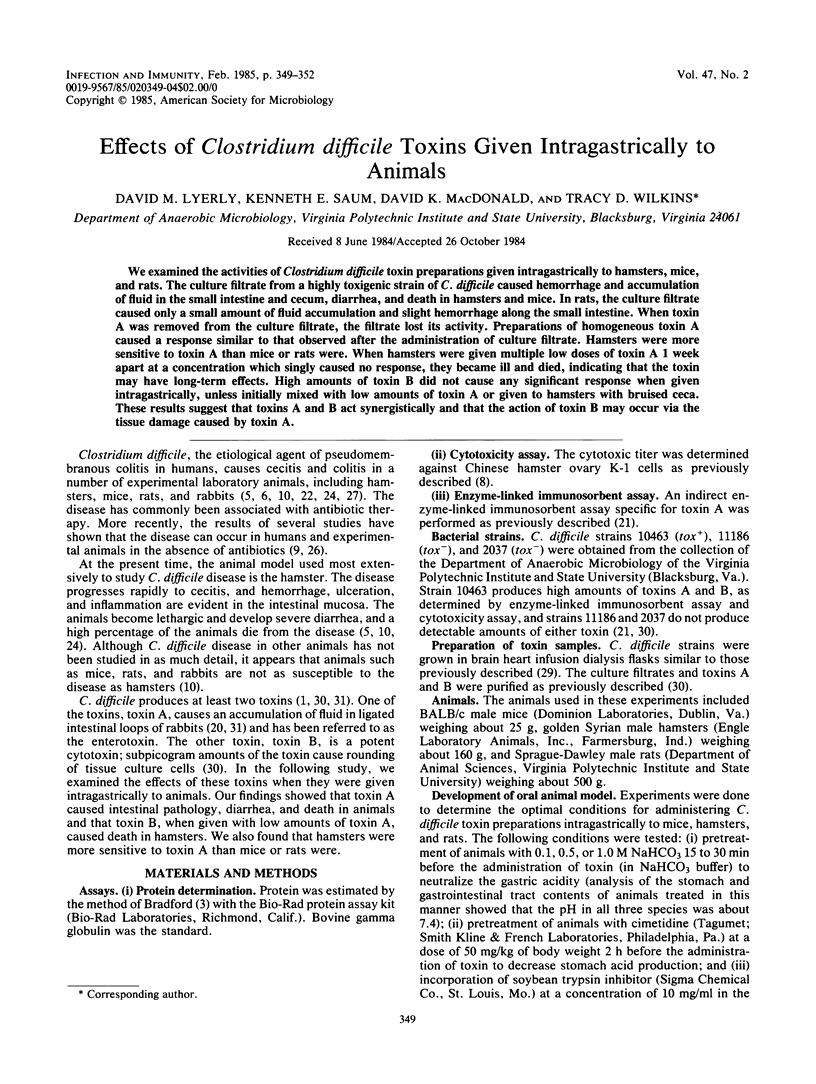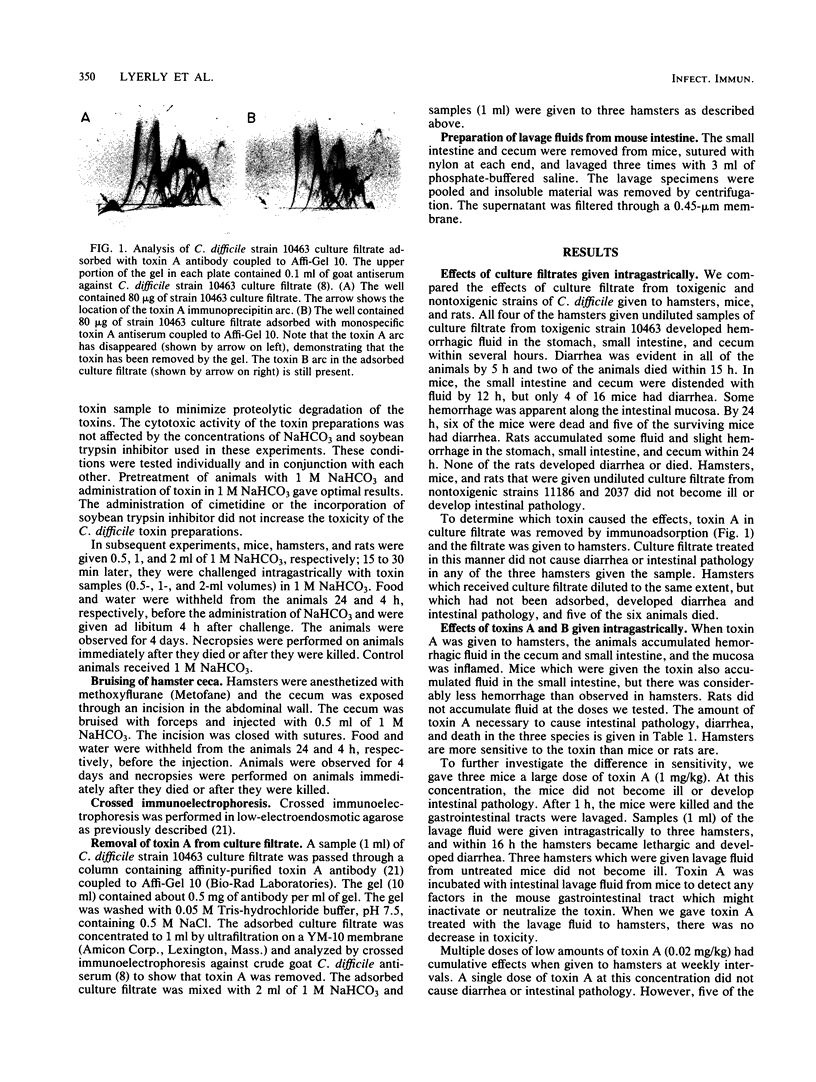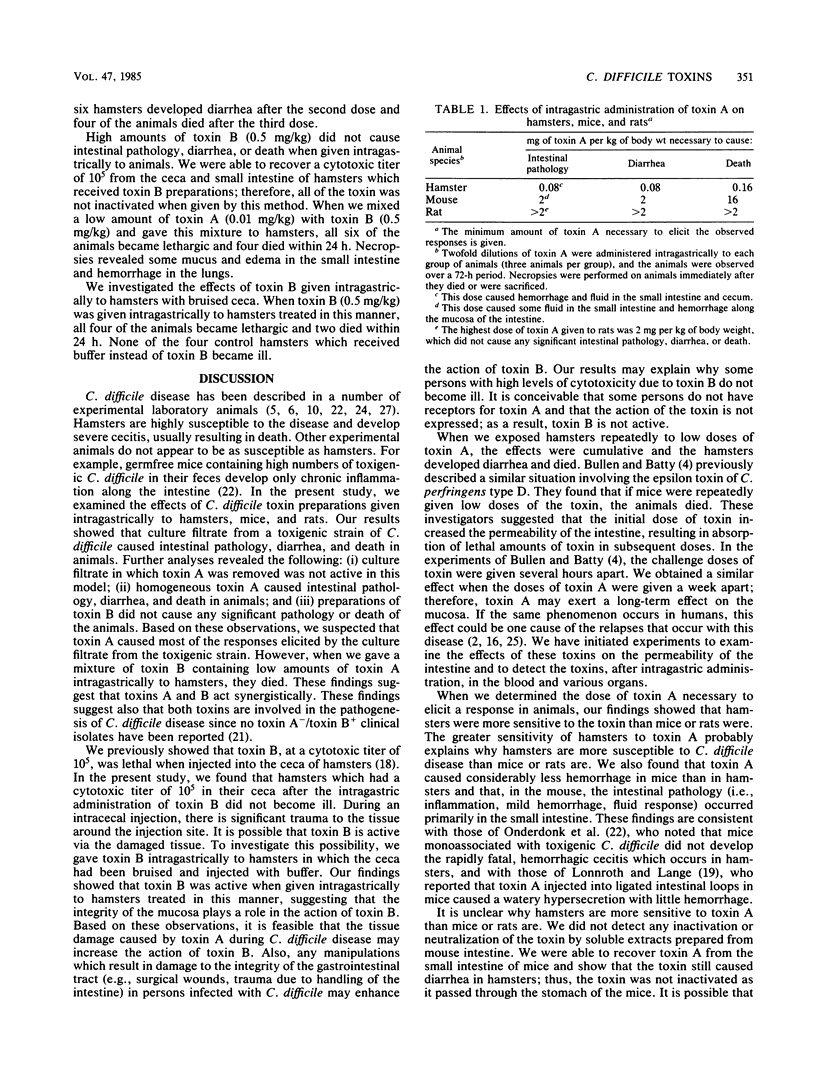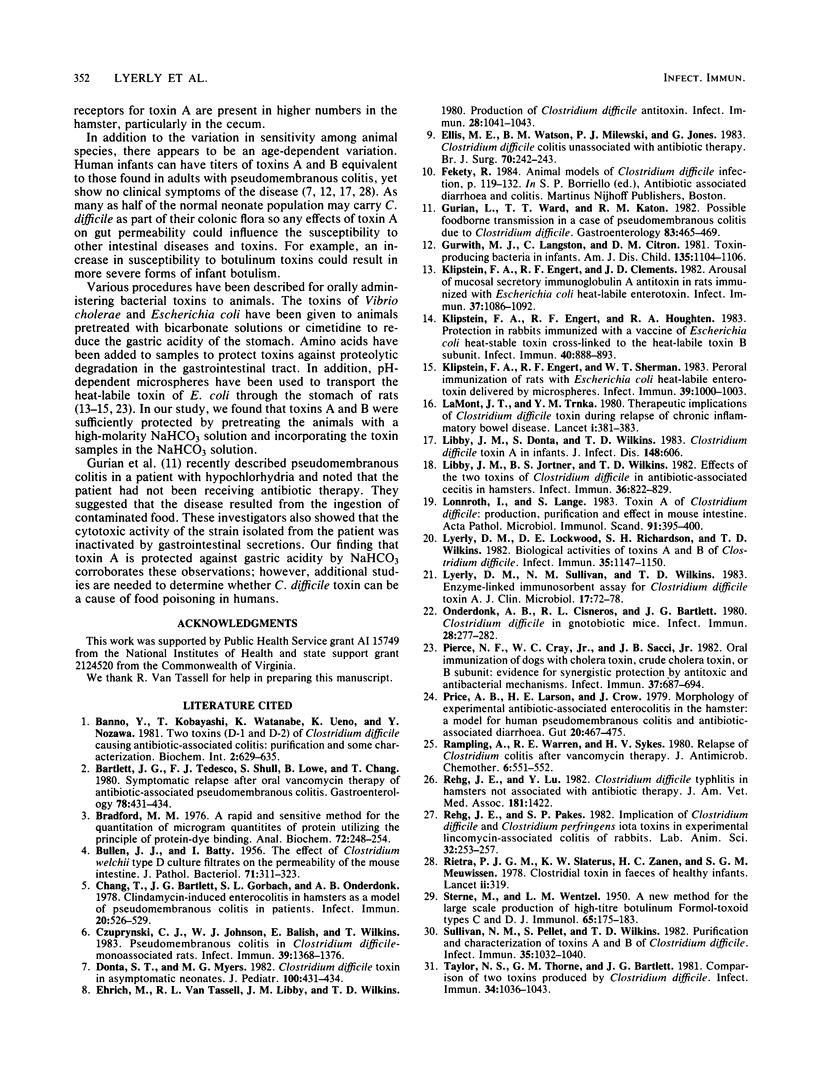Abstract
We examined the activities of Clostridium difficile toxin preparations given intragastrically to hamsters, mice, and rats. The culture filtrate from a highly toxigenic strain of C. difficile caused hemorrhage and accumulation of fluid in the small intestine and cecum, diarrhea, and death in hamsters and mice. In rats, the culture filtrate caused only a small amount of fluid accumulation and slight hemorrhage along the small intestine. When toxin A was removed from the culture filtrate, the filtrate lost its activity. Preparations of homogeneous toxin A caused a response similar to that observed after the administration of culture filtrate. Hamsters were more sensitive to toxin A than mice or rats were. When hamsters were given multiple low doses of toxin A 1 week apart at a concentration which singly caused no response, they became ill and died, indicating that the toxin may have long-term effects. High amounts of toxin B did not cause any significant response when given intragastrically, unless initially mixed with low amounts of toxin A or given to hamsters with bruised ceca. These results suggest that toxins A and B act synergistically and that the action of toxin B may occur via the tissue damage caused by toxin A.
Full text
PDF



Images in this article
Selected References
These references are in PubMed. This may not be the complete list of references from this article.
- BATTY I., BULLEN J. J. The effect of Clostridium welchii type D culture filtrates on the permeability of the mouse intestine. J Pathol Bacteriol. 1956 Apr;71(2):311–323. doi: 10.1002/path.1700710206. [DOI] [PubMed] [Google Scholar]
- Bartlett J. G., Tedesco F. J., Shull S., Lowe B., Chang T. Symptomatic relapse after oral vancomycin therapy of antibiotic-associated pseudomembranous colitis. Gastroenterology. 1980 Mar;78(3):431–434. [PubMed] [Google Scholar]
- Bradford M. M. A rapid and sensitive method for the quantitation of microgram quantities of protein utilizing the principle of protein-dye binding. Anal Biochem. 1976 May 7;72:248–254. doi: 10.1016/0003-2697(76)90527-3. [DOI] [PubMed] [Google Scholar]
- Chang T. W., Bartlett J. G., Gorbach S. L., Onderdonk A. B. Clindamycin-induced enterocolitis in hamsters as a model of pseudomembranous colitis in patients. Infect Immun. 1978 May;20(2):526–529. doi: 10.1128/iai.20.2.526-529.1978. [DOI] [PMC free article] [PubMed] [Google Scholar]
- Czuprynski C. J., Johnson W. J., Balish E., Wilkins T. Pseudomembranous colitis in Clostridium difficile-monoassociated rats. Infect Immun. 1983 Mar;39(3):1368–1376. doi: 10.1128/iai.39.3.1368-1376.1983. [DOI] [PMC free article] [PubMed] [Google Scholar]
- Donta S. T., Myers M. G. Clostridium difficile toxin in asymptomatic neonates. J Pediatr. 1982 Mar;100(3):431–434. doi: 10.1016/s0022-3476(82)80454-x. [DOI] [PubMed] [Google Scholar]
- Ehrich M., Van Tassell R. L., Libby J. M., Wilkins T. D. Production of Clostridium difficile antitoxin. Infect Immun. 1980 Jun;28(3):1041–1043. doi: 10.1128/iai.28.3.1041-1043.1980. [DOI] [PMC free article] [PubMed] [Google Scholar]
- Ellis M. E., Watson B. M., Milewski P. J., Jones G. Clostridium difficile colitis unassociated with antibiotic therapy. Br J Surg. 1983 Apr;70(4):242–243. doi: 10.1002/bjs.1800700420. [DOI] [PubMed] [Google Scholar]
- Gurian L., Ward T. T., Katon R. M. Possible foodborne transmission in a case of pseudomembranous colitis due to Clostridium difficile: influence of gastrointestinal secretions on Clostridium difficile infection. Gastroenterology. 1982 Aug;83(2):465–469. [PubMed] [Google Scholar]
- Gurwith M. J., Langston C., Citron D. M. Toxin-producing bacteria in infants. Lack of an association with sudden infant death syndrome. Am J Dis Child. 1981 Dec;135(12):1104–1106. doi: 10.1001/archpedi.1981.02130360012006. [DOI] [PubMed] [Google Scholar]
- Klipstein F. A., Engert R. F., Clements J. D. Arousal of mucosal secretory immunoglobulin A antitoxin in rats immunized with Escherichia coli heat-labile enterotoxin. Infect Immun. 1982 Sep;37(3):1086–1092. doi: 10.1128/iai.37.3.1086-1092.1982. [DOI] [PMC free article] [PubMed] [Google Scholar]
- Klipstein F. A., Engert R. F., Houghten R. A. Protection in rabbits immunized with a vaccine of Escherichia coli heat-stable toxin cross-linked to the heat-labile toxin B subunit. Infect Immun. 1983 Jun;40(3):888–893. doi: 10.1128/iai.40.3.888-893.1983. [DOI] [PMC free article] [PubMed] [Google Scholar]
- Klipstein F. A., Engert R. F., Sherman W. T. Peroral immunization of rats with Escherichia coli heat-labile enterotoxin delivered by microspheres. Infect Immun. 1983 Feb;39(2):1000–1003. doi: 10.1128/iai.39.2.1000-1003.1983. [DOI] [PMC free article] [PubMed] [Google Scholar]
- LaMont J. T., Trnka Y. M. Therapeutic implications of Clostridium difficile toxin during relapse of chronic inflammatory bowel disease. Lancet. 1980 Feb 23;1(8165):381–383. doi: 10.1016/s0140-6736(80)90939-3. [DOI] [PubMed] [Google Scholar]
- Libby J. M., Donta S. T., Wilkins T. D. Clostridium difficile toxin A in infants. J Infect Dis. 1983 Sep;148(3):606–606. doi: 10.1093/infdis/148.3.606. [DOI] [PubMed] [Google Scholar]
- Libby J. M., Jortner B. S., Wilkins T. D. Effects of the two toxins of Clostridium difficile in antibiotic-associated cecitis in hamsters. Infect Immun. 1982 May;36(2):822–829. doi: 10.1128/iai.36.2.822-829.1982. [DOI] [PMC free article] [PubMed] [Google Scholar]
- Lyerly D. M., Lockwood D. E., Richardson S. H., Wilkins T. D. Biological activities of toxins A and B of Clostridium difficile. Infect Immun. 1982 Mar;35(3):1147–1150. doi: 10.1128/iai.35.3.1147-1150.1982. [DOI] [PMC free article] [PubMed] [Google Scholar]
- Lyerly D. M., Sullivan N. M., Wilkins T. D. Enzyme-linked immunosorbent assay for Clostridium difficile toxin A. J Clin Microbiol. 1983 Jan;17(1):72–78. doi: 10.1128/jcm.17.1.72-78.1983. [DOI] [PMC free article] [PubMed] [Google Scholar]
- Lönnroth I., Lange S. Toxin A of Clostridium difficile: production, purification and effect in mouse intestine. Acta Pathol Microbiol Immunol Scand B. 1983 Dec;91(6):395–400. doi: 10.1111/j.1699-0463.1983.tb00066.x. [DOI] [PubMed] [Google Scholar]
- Onderdonk A. B., Cisneros R. L., Bartlett J. G. Clostridium difficile in gnotobiotic mice. Infect Immun. 1980 Apr;28(1):277–282. doi: 10.1128/iai.28.1.277-282.1980. [DOI] [PMC free article] [PubMed] [Google Scholar]
- Pierce N. F., Cray W. C., Jr, Sacci J. B., Jr Oral immunization of dogs with purified cholera toxin, crude cholera toxin, or B subunit: evidence for synergistic protection by antitoxic and antibacterial mechanisms. Infect Immun. 1982 Aug;37(2):687–694. doi: 10.1128/iai.37.2.687-694.1982. [DOI] [PMC free article] [PubMed] [Google Scholar]
- Price A. B., Larson H. E., Crow J. Morphology of experimental antibiotic-associated enterocolitis in the hamster: a model for human pseudomembranous colitis and antibiotic-associated diarrhoea. Gut. 1979 Jun;20(6):467–475. doi: 10.1136/gut.20.6.467. [DOI] [PMC free article] [PubMed] [Google Scholar]
- Rampling A., Warren R. E., Sykes H. V. Relapse of Clostridium colitis after vancomycin therapy. J Antimicrob Chemother. 1980 Jul;6(4):551–552. doi: 10.1093/jac/6.4.551. [DOI] [PubMed] [Google Scholar]
- Rehg J. E., Lu Y. S. Clostridium difficile typhlitis in hamsters not associated with antibiotic therapy--. J Am Vet Med Assoc. 1982 Dec 1;181(11):1422–1423. [PubMed] [Google Scholar]
- Rehg J. E., Pakes S. P. Implication of Clostridium difficile and Clostridium perfringens iota toxins in experimental lincomycin-associated colitis of rabbits. Lab Anim Sci. 1982 Jun;32(3):253–257. [PubMed] [Google Scholar]
- Rietra P. J., Slaterus K. W., Zanen H. C., Meuwissen S. G. Clostridial toxin in faeces of healthy infants. Lancet. 1978 Aug 5;2(8084):319–319. doi: 10.1016/s0140-6736(78)91723-3. [DOI] [PubMed] [Google Scholar]
- STERNE M., WENTZEL L. M. A new method for the large-scale production of high-titre botulinum formol-toxoid types C and D. J Immunol. 1950 Aug;65(2):175–183. [PubMed] [Google Scholar]
- Sullivan N. M., Pellett S., Wilkins T. D. Purification and characterization of toxins A and B of Clostridium difficile. Infect Immun. 1982 Mar;35(3):1032–1040. doi: 10.1128/iai.35.3.1032-1040.1982. [DOI] [PMC free article] [PubMed] [Google Scholar]
- Taylor N. S., Thorne G. M., Bartlett J. G. Comparison of two toxins produced by Clostridium difficile. Infect Immun. 1981 Dec;34(3):1036–1043. doi: 10.1128/iai.34.3.1036-1043.1981. [DOI] [PMC free article] [PubMed] [Google Scholar]



